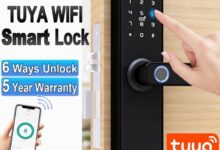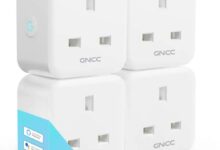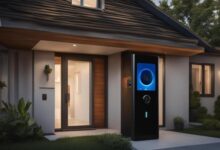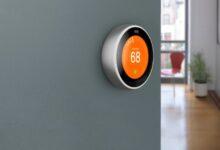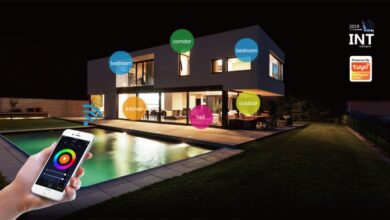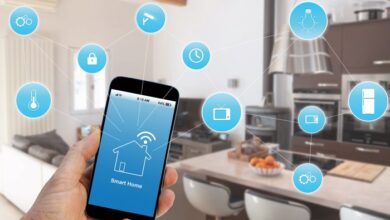Smart Home Hub Your Connected Home Awaits
Smart Home Hubs: Imagine a world where your home anticipates your needs, adjusting lighting, temperature, and entertainment with effortless grace. This isn’t science fiction; it’s the reality smart home hubs offer. From central command centers orchestrating a symphony of smart devices to decentralized systems offering granular control, the possibilities are vast and constantly evolving. We’ll delve into the heart of this technology, exploring its capabilities, security considerations, and the exciting future it promises.
This exploration will cover the core functionality of these hubs, examining the differences between centralized and decentralized systems, and comparing popular brands like Amazon Alexa, Google Home, and Apple HomeKit. We’ll dissect compatibility issues, the crucial role of APIs, and best practices for securing your smart home network. We’ll also look at user interface design, emerging trends like AI integration and energy management, and the long-term cost implications of embracing this technology.
Ultimately, we aim to empower you with the knowledge to make informed decisions about building your own connected home.
Defining Smart Home Hubs
Smart home hubs are the central nervous systems of your connected home, acting as the bridge between your various smart devices and allowing you to control them all from a single point. Think of it as a conductor orchestrating a symphony of smart devices, ensuring seamless communication and automation. Understanding their core functionality is key to unlocking the full potential of a truly integrated smart home.Smart home hubs receive commands from you, typically through voice assistants, mobile apps, or physical interfaces, and then translate those commands into actions for your connected devices.
This includes tasks such as adjusting lighting, controlling thermostats, locking doors, playing music, and much more. The level of integration and sophistication varies greatly depending on the hub and the devices it supports.
Types of Smart Home Hubs
Smart home hubs fall into two primary categories: centralized and decentralized systems. Centralized systems, like those offered by Amazon, Google, and Apple, rely on a single hub to manage all connected devices. This provides a unified control point and often simplifies setup and management. Decentralized systems, on the other hand, distribute control across multiple devices or platforms, offering more flexibility but potentially sacrificing ease of use.
Each approach presents its own advantages and disadvantages depending on the user’s needs and technical expertise.
Comparison of Smart Home Hub Capabilities
Amazon Alexa, Google Home, and Apple HomeKit represent three of the most popular smart home hub ecosystems. Each boasts unique strengths and weaknesses. Amazon Alexa excels in its vast library of compatible smart home devices and its robust voice assistant capabilities. Google Home integrates seamlessly with other Google services and offers strong voice recognition. Apple HomeKit prioritizes security and privacy, providing a tightly controlled ecosystem with end-to-end encryption for many devices.
The choice of hub often comes down to personal preference, existing smart device ecosystem, and prioritization of specific features.
Key Features Comparison of Popular Smart Home Hubs
| Feature | Amazon Alexa | Google Home | Apple HomeKit |
|---|---|---|---|
| Voice Assistant | Alexa | Google Assistant | Siri |
| Device Compatibility | Very wide | Wide | Relatively narrow, but focuses on security and privacy |
| Smart Home Automation | Extensive routines and automations | Robust automation capabilities | Strong automation features, emphasizing security |
| Cost | Various, from affordable smart speakers to high-end displays | Various, from affordable smart speakers to high-end displays | Requires Apple devices and often involves purchasing HomePod mini or similar devices. |
Smart Home Hub Compatibility and Integrations
The seamless integration of various smart home devices is paramount to a truly effective and user-friendly smart home experience. A smart home hub acts as the central nervous system, orchestrating communication between seemingly disparate devices and services. However, achieving this seamless integration presents significant technical challenges, largely stemming from the diversity of communication protocols and manufacturer-specific implementations. Understanding these challenges and the solutions employed is crucial for both consumers choosing a smart home system and developers building the next generation of smart home technology.The success of any smart home ecosystem hinges on its ability to connect and control a wide range of devices.
This requires careful consideration of the various communication protocols employed by different manufacturers. Different protocols often lead to incompatibility issues, highlighting the need for robust and adaptable hub designs.
Common Smart Home Protocols and Hub Compatibility
Smart home devices utilize a variety of communication protocols, each with its strengths and weaknesses. Zigbee, Z-Wave, and Wi-Fi are among the most prevalent. Zigbee, known for its low-power consumption and mesh networking capabilities, excels in connecting battery-powered devices. Z-Wave, another popular choice, offers robust security and reliable range. Wi-Fi, while ubiquitous, can be less energy-efficient and more susceptible to interference.
The compatibility of a smart home hub depends on the protocols it supports. For instance, a hub supporting only Wi-Fi will be unable to integrate Zigbee-based devices without additional bridges or gateways. Many modern hubs aim for broad compatibility by supporting multiple protocols, offering a more inclusive ecosystem. This broad support, however, often comes at the cost of increased complexity in the hub’s software and hardware.
Challenges of Integrating Devices from Various Manufacturers
Integrating devices from different manufacturers presents a significant hurdle. Even when devices use the same protocol, variations in implementation can cause incompatibility. Manufacturers may use proprietary extensions or variations of standard protocols, creating interoperability issues. This is further complicated by the lack of standardized APIs or inconsistent API implementations across different manufacturers. A successful integration requires careful consideration of these variations and the development of robust error handling and fallback mechanisms within the smart home hub’s software.
Consider the scenario where two light bulbs, both using Zigbee, fail to communicate effectively due to subtle differences in their firmware. This necessitates either manufacturer intervention or sophisticated workarounds within the hub’s software to reconcile these discrepancies.
The Role of APIs in Enabling Device Integration
Application Programming Interfaces (APIs) are fundamental to enabling device integration. APIs act as intermediaries, allowing the smart home hub to communicate with devices from different manufacturers. A well-designed API provides a standardized way for the hub to send commands and receive data from devices, regardless of their underlying communication protocols or manufacturer-specific implementations. However, the reliance on APIs introduces another layer of complexity.
APIs need to be well-documented, consistently maintained, and securely implemented to ensure reliable integration. A poorly designed or poorly maintained API can significantly impact the stability and reliability of the entire smart home ecosystem. For example, if a manufacturer abruptly changes its API without adequate notification, it can render previously compatible devices unusable.
Examples of Successful and Unsuccessful Device Integrations
The Amazon Echo and Google Home hubs exemplify successful device integration strategies. Both have amassed extensive device compatibility through partnerships with numerous manufacturers and a commitment to developing robust APIs. This broad compatibility is a key factor in their market dominance. In contrast, some lesser-known smart home hubs struggle with limited device compatibility, hindering their adoption and usefulness.
The success of these integrations often boils down to the manufacturers’ willingness to collaborate, adhere to open standards, and invest in robust API development and maintenance. A striking example of an unsuccessful integration might involve a smart lock that only communicates via a proprietary protocol not supported by common smart home hubs, thereby limiting its interoperability and value to the end-user.
This highlights the importance of open standards and collaborative efforts in creating a truly interconnected smart home ecosystem.
Security and Privacy Concerns
The convenience and automation offered by smart home hubs come with inherent security and privacy risks. Understanding these vulnerabilities and implementing robust security measures is crucial for protecting your personal data and ensuring the safety of your home. Ignoring these concerns can lead to significant consequences, ranging from minor inconveniences to major security breaches with potentially devastating effects.
Smart home hubs, while designed to simplify your life, act as central points of control for numerous connected devices. This centralized architecture, while efficient, creates a single point of failure that malicious actors could exploit. A compromised hub could grant access to your entire smart home network, potentially exposing sensitive information and enabling physical control over your home’s systems.
Best Practices for Securing a Smart Home Network
Implementing a layered security approach is vital for protecting your smart home. This involves a combination of strong passwords, regular software updates, and network segmentation to minimize the impact of a potential breach.
- Use strong, unique passwords for your hub and all connected devices. Avoid easily guessable passwords or reusing passwords across multiple accounts.
- Enable two-factor authentication (2FA) whenever possible. This adds an extra layer of security, making it significantly harder for unauthorized individuals to access your system.
- Keep your smart home hub’s firmware updated. Regular updates often include critical security patches that address known vulnerabilities.
- Segment your smart home network. Create a separate network for your IoT devices to isolate them from your main network, limiting the damage if one device is compromised.
- Regularly review the permissions granted to your smart home apps and devices. Revoke access to any apps or devices you no longer use.
Potential Vulnerabilities Associated with Smart Home Hubs
Smart home hubs, like any connected device, are susceptible to various security threats. These vulnerabilities can be exploited by malicious actors to gain unauthorized access and control over your home network and devices.
- Weak or Default Passwords: Many users fail to change default passwords, leaving their hubs vulnerable to brute-force attacks.
- Software Vulnerabilities: Outdated firmware can contain unpatched security flaws that attackers can exploit.
- Insecure Wi-Fi Networks: Connecting your hub to an unsecured Wi-Fi network exposes it to eavesdropping and man-in-the-middle attacks.
- Lack of Encryption: Insufficient encryption can allow attackers to intercept data transmitted between your hub and connected devices.
- Third-Party App Vulnerabilities: Security flaws in third-party apps integrated with your hub can create entry points for attackers.
Hypothetical Security Breach Scenario
Imagine a scenario where a user fails to update their smart home hub’s firmware. A known vulnerability in the outdated firmware is exploited by a malicious actor who gains remote access to the hub. The attacker then uses this access to control the user’s smart locks, disabling them and gaining physical entry to the home. Further, they access and steal sensitive data from connected devices, such as security camera footage or personal information stored on smart speakers.
Recommendations for Mitigating Security Risks
Proactive measures are crucial in minimizing the risk of a security breach. By adopting a multi-layered security approach and staying informed about emerging threats, users can significantly improve their smart home’s security posture.
- Choose reputable brands with a strong security track record.
- Regularly review and update the security settings of your smart home hub and connected devices.
- Use strong, unique passwords and enable two-factor authentication wherever possible.
- Keep your smart home hub’s firmware updated to the latest version.
- Use a strong, encrypted Wi-Fi network and consider segmenting your smart home network.
- Be cautious about the third-party apps you integrate with your smart home hub and regularly review their permissions.
- Monitor your network traffic for suspicious activity.
User Experience and Interface Design
A seamless and intuitive user experience is paramount for any smart home hub. The interface should act as a bridge, effortlessly connecting users with their smart devices and simplifying complex tasks. A poorly designed interface can lead to frustration and ultimately, abandonment of the entire smart home system. This section explores the key elements of an ideal smart home hub interface, comparing existing examples and proposing a model prioritizing accessibility.The ideal user interface for a smart home hub prioritizes simplicity, clarity, and personalization.
It should offer a clear visual hierarchy, presenting essential information prominently while allowing users to easily access more granular controls when needed. Visual cues, such as color-coding and intuitive icons, should guide users through various functionalities. The interface should be highly customizable, allowing users to tailor the layout and displayed information to their specific needs and preferences.
Think of it as a personalized dashboard reflecting the user’s individual smart home ecosystem.
Comparison of Smart Home Hub Interfaces
Several popular smart home hubs offer vastly different user experiences. Amazon’s Alexa app, for instance, is known for its straightforward design and voice-control integration, although some users find its organization less intuitive for managing complex scenes. Google Home’s interface is similarly user-friendly but provides a stronger emphasis on visual representation of connected devices. Apple’s HomeKit, while elegantly minimalist, can feel restrictive for users accustomed to greater customization options.
These differences highlight the diverse approaches to interface design and the importance of catering to varied user preferences. A successful hub needs to find a balance between simplicity and comprehensive functionality.
Intuitive Navigation and Control
Intuitive navigation and control are fundamental to a positive user experience. The interface should allow users to quickly locate and interact with their devices, whether through voice commands, touch gestures, or a combination of both. Nested menus should be avoided whenever possible, and frequently used functions should be readily accessible from the main screen. For example, quickly adjusting the thermostat temperature or turning on/off lights should be a single tap or voice command away.
This ease of use directly impacts user adoption and satisfaction. A system that requires multiple steps to perform basic tasks will inevitably lead to frustration and underutilization.
Accessible Smart Home Hub Interface Mock-up
Imagine a smart home hub interface designed with accessibility in mind. The main screen displays large, high-contrast icons representing major device categories (lighting, climate, security, entertainment). Users can customize the size and arrangement of these icons. Text is clear and legible, with adjustable font sizes. Colorblind-friendly palettes are employed, and alternative text descriptions are provided for all visual elements.
Voice control is fully integrated, providing an alternative input method for users with motor impairments. Contextual help and tutorials are readily available, guiding users through various functions. The overall aesthetic is clean and uncluttered, minimizing visual distractions and ensuring effortless navigation. This design aims to ensure that the benefits of smart home technology are accessible to everyone, regardless of their abilities.
Future Trends and Innovations
The smart home hub, once a niche technology, is rapidly evolving into the central nervous system of our homes. Its future hinges on advancements in artificial intelligence, innovative hardware, and a growing focus on sustainability. The potential for these technologies to reshape the smart home experience is immense, promising a level of convenience, efficiency, and personalization never before seen.The integration of AI and machine learning is poised to revolutionize smart home hub functionality.
Moving beyond simple automation, these technologies will enable predictive capabilities, proactive problem-solving, and personalized experiences tailored to individual user preferences and routines.
AI and Machine Learning Enhancements
AI and machine learning will empower smart home hubs to learn user behaviors and preferences over time, optimizing energy consumption, automating tasks more effectively, and anticipating needs before they are explicitly stated. Imagine a hub that learns your morning routine and automatically adjusts the lighting, temperature, and coffee maker based on your usual schedule, even adjusting for slight variations.
Furthermore, AI can proactively identify and address potential issues, such as detecting a malfunctioning appliance before it causes a larger problem, or optimizing energy usage based on real-time pricing and weather conditions. This predictive capability will transform the smart home from a reactive system to a proactive partner in managing daily life. Consider the example of Nest Learning Thermostat, which learns your preferences and adjusts accordingly, significantly reducing energy waste.
This is just a glimpse of what’s possible with more advanced AI integration.
Emerging Trends in Smart Home Technology
Several emerging trends are significantly impacting the capabilities and functionality of smart home hubs. The rise of Matter, a new standard for smart home connectivity, is crucial as it promises to improve interoperability between devices from different manufacturers. The integration of more sophisticated sensors, capable of detecting a wider range of data points, is another key trend. This enhanced data collection will enable more nuanced and personalized control over various aspects of the home environment.
Moreover, the increasing adoption of voice assistants and natural language processing is streamlining user interaction with smart home systems. The seamless integration of these technologies within the smart home hub will further enhance user experience and simplify the management of connected devices. For example, the ability to control lighting, temperature, and entertainment systems simply by voice command will significantly improve ease of use.
Smart Home Hubs and Energy Management
Smart home hubs are increasingly playing a crucial role in energy management and sustainability. By monitoring energy consumption in real-time, these hubs can identify areas of inefficiency and suggest adjustments to reduce energy waste. This is particularly relevant given the growing concerns about climate change and the rising costs of energy. Integration with renewable energy sources, such as solar panels, allows for optimization of energy usage based on availability.
The ability to schedule energy consumption during off-peak hours can further contribute to cost savings and reduced environmental impact. For instance, a smart home hub could automatically shift the operation of energy-intensive appliances, such as washing machines and dishwashers, to times when energy prices are lower or renewable energy is abundant. This functionality promotes both financial savings and environmental responsibility.
Conceptual Futuristic Smart Home Hub
Imagine a sleek, minimalist hub, seamlessly integrated into the home’s architecture, perhaps resembling a piece of modern art rather than a traditional device. This hub would utilize advanced AI to anticipate and fulfill user needs, proactively managing energy consumption, security systems, and entertainment based on learned preferences and real-time data analysis. Its interface would be intuitive and personalized, perhaps projected onto any surface using augmented reality, eliminating the need for a dedicated screen.
Discover how Smart Lighting has transformed methods in this topic.
Advanced sensors would monitor not only energy usage but also air quality, humidity, and even occupant health, automatically adjusting the environment to maintain optimal conditions. This hub would be the ultimate orchestrator of a truly intelligent and sustainable home, offering an unprecedented level of comfort, convenience, and efficiency. This system would integrate seamlessly with other smart devices, acting as a central command center that anticipates user needs and proactively manages the home environment, ensuring optimal comfort, security, and energy efficiency.
Smart Home Hub Applications and Use Cases
Smart home hubs have rapidly evolved from niche gadgets to essential components of modern living, transforming how we interact with our homes and impacting both residential and commercial spaces. Their versatility allows for seamless integration of various smart devices, automating tasks, enhancing security, and ultimately improving our daily lives. This section explores the diverse applications and use cases of smart home hubs across different environments.Smart home hubs offer a centralized control point for a wide range of devices, simplifying complex systems and creating a more intuitive user experience.
The ability to automate routines, monitor energy consumption, and enhance security features contributes to significant improvements in efficiency and convenience. The implications extend beyond personal comfort, impacting areas such as accessibility for individuals with disabilities and contributing to the development of more sustainable living environments.
Residential Smart Home Applications
The most common application of smart home hubs is within residential settings. Imagine a scenario where you wake up to the gentle sound of your smart alarm clock. The hub automatically triggers the coffee maker, adjusts the thermostat to your preferred temperature, and dims the lights gradually to simulate a sunrise. As you leave for work, the hub locks the doors, arms the security system, and adjusts the smart blinds to optimize natural light.
Later, when you return home, the lights automatically switch on, the thermostat adjusts to a comfortable temperature, and your favorite music starts playing. This integrated system not only enhances comfort but also increases security and energy efficiency. For example, the ability to remotely monitor energy usage allows for informed adjustments, leading to potential cost savings. Furthermore, features such as automated lighting can deter potential intruders, improving overall home security.
Commercial Smart Home Hub Applications
Beyond residential use, smart home hubs are finding increasing applications in commercial settings. Hotels are leveraging hubs to create personalized guest experiences, offering automated room controls and enhanced security features. Office spaces utilize hubs to optimize energy consumption, manage lighting and climate control, and enhance security through integrated surveillance systems. Retail stores can use smart hubs to manage inventory, track customer traffic, and optimize lighting based on foot traffic patterns.
The benefits extend to improved efficiency, reduced operational costs, and enhanced security. For instance, a retail store could use sensors to automatically adjust lighting based on daylight levels, minimizing energy waste and reducing operational costs. The data collected can also inform business decisions, such as optimizing product placement or adjusting store hours based on customer traffic patterns.
Smart hubs are becoming an increasingly important tool for businesses seeking to improve efficiency and optimize their operations.
Future Applications of Smart Home Hubs
The potential applications of smart home hubs extend far beyond current capabilities. Future advancements in artificial intelligence (AI) and machine learning (ML) will enable more sophisticated automation and personalization. We can anticipate more predictive capabilities, such as anticipating your needs before you even ask, and proactive maintenance alerts for appliances. Imagine a hub that anticipates your need for a specific item, such as ordering groceries before they run out, or automatically adjusting the heating based on the weather forecast.
The integration of smart home hubs with other technologies, such as virtual assistants and wearable devices, will further enhance their functionality. The potential for integrating with healthcare systems to monitor elderly individuals or individuals with disabilities is also a significant area of future development. The continued growth and evolution of smart home technology promises to bring even greater convenience, efficiency, and security to our lives in the years to come.
For example, the integration of smart home hubs with medical devices could enable remote health monitoring, providing critical data to healthcare providers and enabling proactive interventions.
Cost and Value Proposition
The decision to embrace a smart home often hinges on a careful consideration of cost versus the benefits received. Smart home hubs, the central nervous system of this interconnected ecosystem, vary significantly in price, impacting both initial investment and long-term expenses. Understanding this cost-benefit analysis is crucial for making an informed purchase. This section delves into the pricing structures of various smart home hubs, examines the ongoing maintenance costs, and explores the value proposition for diverse user groups.
Smart home hub pricing reflects the sophistication of their features and capabilities. Entry-level hubs might offer basic smart home control for a modest price, while more advanced systems with enhanced features, such as advanced automation, robust security protocols, and extensive third-party integrations, command a higher price tag. This price difference directly correlates with the range of functions and the level of control offered to the user.
Smart Home Hub Pricing Comparison
A direct comparison of smart home hubs reveals a broad spectrum of pricing. For instance, a basic hub focusing solely on lighting and appliance control might cost around $50-$100, whereas a comprehensive hub offering voice control, advanced automation, and extensive integrations could range from $150-$300 or even more. The price often reflects the brand reputation, feature set, and ecosystem integration capabilities.
Consider factors such as the number of devices supported, the inclusion of extra smart home devices in the package, and the availability of subscription services that unlock advanced functionalities.
Long-Term Costs of Smart Home Hub Ownership
Beyond the initial purchase price, several ongoing costs contribute to the total cost of ownership. These include potential subscription fees for cloud services, which are often required for remote access and advanced features. Additionally, maintaining and updating the system might involve replacing aging components or upgrading to newer versions of the hub to support evolving smart home technologies.
The frequency and cost of these updates depend on the hub’s lifespan and technological advancements in the smart home sector. Unexpected repairs or replacements of malfunctioning devices connected to the hub also add to the long-term costs.
Value Proposition for Different User Demographics
The value proposition of a smart home hub varies significantly depending on the user’s needs and lifestyle. For tech-savvy individuals who enjoy automation and control, a sophisticated, feature-rich hub offers significant value, justifying a higher initial investment. For budget-conscious users, a basic hub with limited functionality might suffice. Families with young children might value features like remote monitoring and safety enhancements, whereas elderly individuals might prioritize ease of use and accessibility features.
Consideration should also be given to the size of the home and the number of smart devices being controlled; a larger home with more devices would likely benefit from a more robust and scalable hub.
Total Cost of Ownership Comparison
The following table illustrates a hypothetical five-year total cost of ownership for three different smart home hub systems: a basic, a mid-range, and a premium system. These figures are estimates and can vary based on individual usage and maintenance needs.
| Hub Type | Initial Cost | Annual Subscription (Avg.) | Maintenance/Repair (Avg.) | 5-Year Total Cost |
|---|---|---|---|---|
| Basic | $75 | $0 | $25 | $175 |
| Mid-Range | $175 | $30 | $50 | $425 |
| Premium | $300 | $60 | $75 | $875 |
Illustrative Examples of Smart Home Hub Functionality
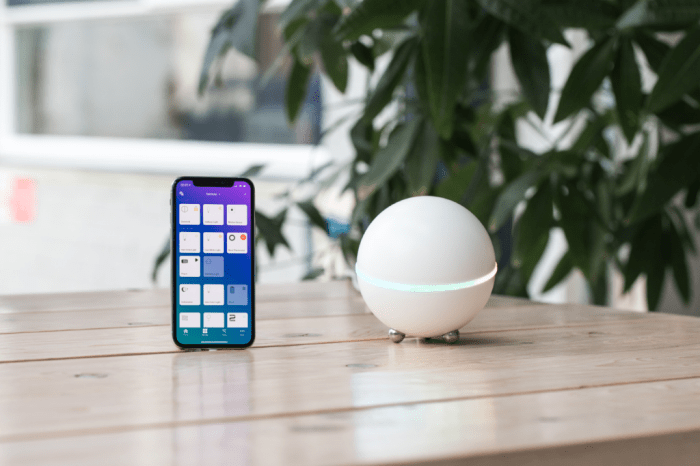
Smart home hubs are the central nervous systems of connected homes, orchestrating the seamless interaction of various smart devices. Understanding their functionality is key to appreciating their value and potential. Let’s explore two key aspects: visualizing the overall status of your connected devices and understanding the execution of automated scenes.
Smart Home Dashboard Visualization
Imagine a crisp, high-resolution display, perhaps on a tablet or a dedicated smart home hub interface. This dashboard provides a real-time snapshot of your entire smart home ecosystem. At a glance, you see a series of intuitively arranged icons, each representing a connected device. These icons might include a stylized representation of a lightbulb for your smart lighting system, a thermostat graphic for your climate control, a door lock for your security system, and even smaller icons for individual smart outlets.
The color-coding of these icons is crucial; a green hue indicates that the device is functioning normally, perhaps with a subtle animation like a gently pulsing light for a lamp that’s currently on. A yellow hue might indicate a device that is operating but requires attention – for instance, a smart water leak detector that’s detecting slightly elevated moisture levels.
Red indicates an issue – a malfunctioning smoke detector, a door that’s unexpectedly unlocked, or a security camera offline. Numerical data, such as the current room temperature or the remaining battery life of a smart sensor, might be subtly overlaid on these icons, allowing for quick assessment of device status without cluttering the display. The overall aesthetic should prioritize clarity and ease of understanding, using a clean, uncluttered layout and intuitive color-coding for immediate comprehension.
This visual representation empowers users to quickly grasp the state of their home and address any potential problems promptly.
Smart Home Automation Scene Representation
Let’s consider a “Good Night” scene. The visual representation of this scene, before execution, might appear as a sequence of actions within the smart home app. Each step would be clearly delineated, perhaps with a small icon next to each action, mirroring the icons on the dashboard. The sequence might start with a dimming of the living room lights, visually represented by a lightbulb icon transitioning from bright yellow to a soft orange.
The next step could be the lowering of the thermostat temperature by a few degrees, depicted by a thermostat icon showing a decrease in temperature. Then, the scene might include locking all exterior doors, represented by lock icons changing from unlocked to locked. Finally, the scene could involve arming the home security system, visually represented by a shield icon that changes color from gray to green, signifying activation.
Upon executing this scene, the visual representation would change to reflect the completed actions, perhaps with checkmarks appearing next to each completed step. The overall outcome is a clean, well-lit, secure, and energy-efficient home, ready for the night. The visual confirmation of the scene’s execution provides peace of mind and transparency in the automation process. A well-designed smart home system prioritizes visual feedback at every stage, offering users a clear understanding of what is happening and when.
This reinforces trust in the system and encourages greater adoption of automation features.
Ending Remarks
The smart home revolution is well underway, and smart home hubs are at its core. From simplifying daily routines to enhancing security and energy efficiency, the benefits are undeniable. While security concerns and compatibility challenges remain, the ongoing innovation in this space promises a future where our homes are not just smarter, but also more intuitive, responsive, and personalized.
Understanding the intricacies of these hubs empowers you to harness their potential and create a truly connected, comfortable, and secure living environment. The journey to a smarter home starts with understanding the technology that makes it all possible.
